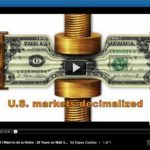If there was ever a year when you wanted a former combat pilot with a current aerobatic license giving you financial advice, it was the one we just completed. After enough loops, spins, barrel rolls, and whip stalls to induce air sickness in the most seasoned of veterans, the major indexes ended almost exactly where they started for the second year in a row. Even the much vaunted barbarous relic gave up a blistering 40% return at its high, to close up at a still decent 14%.

Looking back on my own trade history, I can assure you that I committed plenty of blunders, misjudgments, miscalculations, and fundamental misreadings of human nature. But as I like to tell my passengers, I crash better than anyone I know. That?s important, since they don?t let you practice crashing in flight school. Any landing that you walk, or run away from, is a good one, and the insurance company can always buy you a new plane. From an investment point of view, this means that my winners outnumbered my losers by better than five to one.
I started 2011 with a big splash, correctly believing that the recently announced QE2 and tax compromise would give the markets ample liquidity for me to carry longs over the holidays. So I entered 2011 with positions in the S&P 500 (SSO), the short Treasury ETF (TBT), the grains (JJG), Cisco (CSCO), and Bank of America (BAC), all of which proved profitable.
That allowed my trading book to leap 4.73% on January 3, the first trading day of the year. As the month wore on, I took profits, usually too early. But I always like to leave the last 10% of a move to the next guy. I ended January up 20.6% on the year, a peak I would not match for another ten weeks.
February saw the beginning of a trade drought that lasted nearly three months. I correctly believed that markets were topping, but were too soon to short, and started adding long volatility plays, astutely buying the (VIX) whenever it dropped below $15. I also shorted the yen, which would eventually come to grief.
My big out-of consensus call in March was that Treasury bonds would rise into the end of QE2 on June 30, not crash, as most of the hedge fund community was expecting. I reasoned that the end of $75 billion a month of Federal Reserve asset purchases would trigger a flight to safety move that would send investors piling into government paper. My short sale of deep out of the money puts on Treasuries added 4.53% to my total return.
The first black swan of the year came with the Japanese tsunami on March 11, which caused the Nikkei Index to collapse and the currency to soar. That quickly stopped me out of my short Yen position in the (YCS), causing my first substantial loss of the year of -1.62%.
By the spring, I was receiving daily complaints about the paucity of recent Trade Alerts. That came to an abrupt end on April 28 when I called the top of multiple asset classes at once and started pumping out alerts as fast as a Gatling gun. Out went Trade Alerts to sell Oil (USO), the Euro (FXE), the S&P 500 (SPY), and to buy the dollar (UUP). It was ?sell in May and go away? with a vengeance. By May 23, my performance soared to 38%, another interim peak.
July was a total pig of a month as I totally misunderstood the consequences of the acrimonious debt ceiling negotiations in congress. I made the right call that a deal would be cut at the eleventh hour of the last day. However, instead of triggering a surge of liquidity into assets, the exact opposite happened. Investors viewed the whole sorry affair as proof of how deeply dysfunctional our government has become and ran for the hills.
The hits I took on my premature longs were painful indeed. I violated my own rules and failed to stop out of the (TBT), which would drop for another tortuous four months and end up costing me 7.02%, my biggest loss of the year. But coming from an older generation, and cutting my teeth on the double digit interest rates of the early 1980?s, it is hard for me to believe the ten year yields of 1.80% I see on my screen today.
It took me a couple of days to figure out the new game. But once I did, it was like shooting fish in a barrel, with a string of 22 profitable trades ensuing. In quick succession, I sold short the (SPY), the Russell 2000 (IWM), the Euro, and gold (GLD) several times. I hit a home run shorting the Swiss franc the weekend before the central bank devalued it and tied it to a falling Euro, adding 9.07% to the year. During August I was writing Trade Alerts so fast, up to three a day that I practically wore my fingertips down to their nubs.
By October, the pickings were getting thin. I covered my remaining shorts at the absolute bottom on October 4, but failed to go long. My last really good trade of the year was executed on October 28, when I shorted the Euro one more time for a 5.36% profit. It was enough to take me to my third performance peak of the year of 46.75%.
In October, over confidence, complacency, and a run for a 50% return on the year enticed me to reach for the trade too far. Collapsing volatility in November and December meant that I lost money on my Jeffries (JEF) calls, even though I got the stock right. In the ultimate act of idiocy, I bought silver calls (SLV) on top of an $8 move, hoping the momentum would carry onward for another couple of bucks. It was not to be. That little hickey cost me 4.29%, stopping out the day before the precious metals collapse began in earnest.
After that, I was ready to cash in for the year, locking in a total return of 40.18%, putting me in the top one tenth of one percent of all hedge fund managers. I expected December to be a tedious, low volume affair with declining volatility, offering no great trading opportunities. And nothing beats the ease of a yearend audit of only a single number that is 100% in cash. It leaves one with barrels of dry powder with which to start the New Year. As for my final grade, I?m afraid that I?ll have to give myself an A+ with numbers like this.
We live in an industry where you?re only as good as your last trade. I look at the blank slate in front of me bursting with optimism about the opportunities presented by the coming year. But I also begin humbled, chastened, and wiser from last year?s errors. I never lost money on a trade that I didn?t learn from. That is as true today as it was 48 years ago when I first joined this game.









